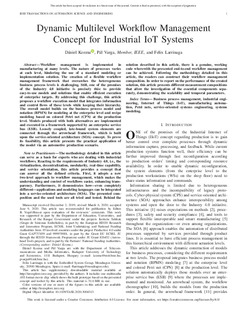| dc.rights.license | Attribution 4.0 International | * |
| dc.contributor.author | Larrinaga, Felix | |
| dc.contributor.other | Kozma, Dániel | |
| dc.contributor.other | Varga, Pal | |
| dc.date.accessioned | 2020-07-06T14:42:01Z | |
| dc.date.available | 2020-07-06T14:42:01Z | |
| dc.date.issued | 2020 | |
| dc.identifier.issn | 1545-5955 | en |
| dc.identifier.other | https://katalogoa.mondragon.edu/janium-bin/janium_login_opac.pl?find&ficha_no=159230 | en |
| dc.identifier.uri | https://hdl.handle.net/20.500.11984/1785 | |
| dc.description.abstract | Workflow management is implemented in manufacturing at many levels. The nature of processes variesat each level, hindering the use of a standard modeling orimplementation solution. The creation of a flexible workflow management framework that overarches the heterogeneous business process levels is challenging. Still, one of the promisesof the Industry 4.0 initiative is precisely this: to provideeasy-to-use models and solutions that enable efficient execution of enterprise targets. By addressing this challenge, this articleproposes a workflow execution model that integrates information and control flows of these levels while keeping their hierarchy. The overall model builds on the business process model andnotation (BPMN) for modeling at the enterprise level and recipemodeling based on colored Petri net (CPN) at the production level. Models produced with both alternatives are implemented and executed in a framework supported by an enterprise servicebus (ESB). Loosely coupled, late-bound system elements are connected through the arrowhead framework, which is builtupon the service-oriented architecture (SOA) concept. To proveits feasibility, this article presents the practical application ofthe model via an automotive production scenario. | en |
| dc.description.sponsorship | Unión Europea | es |
| dc.language.iso | eng | en |
| dc.publisher | IEEE | en |
| dc.rights | © 2020 IEEE. Personal use of this material is permitted. Permission from IEEE must be obtained for all other uses, in any current or future media, including reprinting/republishing this material for advertising or promotional purposes, creating new collective works, for resale or redistribution to servers or lists, or reuse of any copyrighted component of this work in other works | en |
| dc.rights.uri | http://creativecommons.org/licenses/by/4.0/ | * |
| dc.title | Dynamic Multilevel Workflow Management Concept for Industrial IoT Systems | en |
| dcterms.accessRights | http://purl.org/coar/access_right/c_abf2 | en |
| dcterms.source | IEEE Transactions on Automation Science and Engineering | en |
| local.contributor.group | Ingeniería del software y sistemas | es |
| local.description.peerreviewed | true | en |
| local.identifier.doi | https://doi.org/10.1109/TASE.2020.3004313 | en |
| local.relation.projectID | info:eu-repo/grantAgreement/EC/H2020/826452/EU/Arrowhead Tools for Engineering of Digitalisation Solutions/Arrowhead Tools | en |
| local.relation.projectID | info:eu-repo/grantAgreement/EC/H2020/737459/EU/Electronics and ICT as enabler for digital industry and optimized supply chain management covering the entire product lifecycle/PRODUCTIVE4.0 | en |
| local.rights.publicationfee | APC | en |
| local.rights.publicationfeeamount | 1803 EUR | en |
| local.embargo.enddate | 2020 | |
| local.contributor.otherinstitution | https://ror.org/02w42ss30 | |
| local.source.details | Early Access online, 2 julio, 2020 | |
| oaire.format.mimetype | application/pdf | |
| oaire.file | $DSPACE\assetstore | |
| oaire.resourceType | http://purl.org/coar/resource_type/c_6501 | en |
| oaire.version | http://purl.org/coar/version/c_ab4af688f83e57aa | en |








